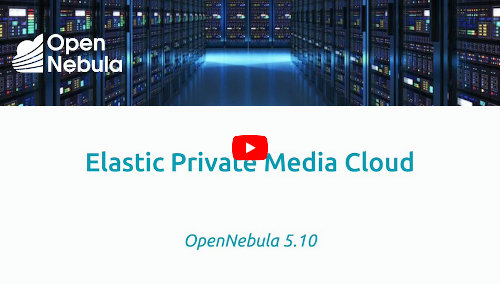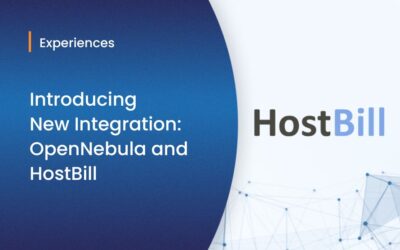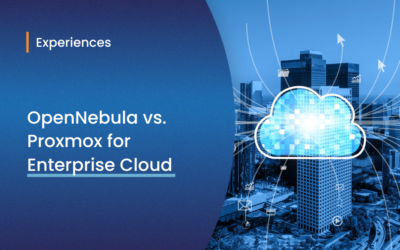Over-the-top (OTT) media is revolutionizing the entertainment industry. We are seeing traditional HTTP streaming formats gain wide acceptance, facilitating the ability to reach viewers at a global scale on almost any device. Live events are being broadcast directly over the internet, allowing for immediate and widespread participation. The technology infrastructure that a broadcasting service company chooses influences its degree of success in the increasingly competitive OTT video market. This article discusses on-premises and public cloud-based approaches to creating live and on-demand OTT video workflows, and introduces an OpenNebula-based solution that brings the benefits of both worlds.
The Traditional On-Premises Approach
On-premises infrastructure has long been a versatile tool to alleviate many of the pains and challenges of providing an adaptable and secure solution for the demands of media services. This centralized, on-premise infrastructure approach—which uses bare-metal servers, and oftentimes, is managed and offered as a private cloud—provides a highly-performant utilization of resources. This dedicated approach reserves all of the resources of physical servers to a single tenant, eliminating the need to share resources across multiple users. No sharing of resources provides improved and predictable performance, along with enhanced isolation and security. It adds extra flexibility to customize the application stack and to choose the operation systems and the hardware specifications to adapt the resources to one’s particular needs.
However, there are technical limitations and challenges that accompany this innovative approach. For example, the demand for live events can erupt quite quickly, jumping from zero to millions of users within a matter of seconds. On-premises infrastructures cannot dynamically adapt to highly variable demands and require an up-front payment of the infrastructure needed to meet those peaks in demand. Additionally, building an on-premise infrastructure capable of meeting those unpredictable peaks requires a significant investment that often leads to a significant amount of physical resources just sitting idle. Moreover, many companies offer media services globally and need to run their services close to their end customers in order to improve their user experience and in many cases meet regulatory issues regarding data privacy.
The Hyperscale Way
Having to own, manage, and administer your own hardware infrastructure is a burden that most organizations would simply prefer to avoid. So the option offered by media services, like AWS Media Services, is one that has taken root in recent years. It provides a model that liberates organizations from owning and having to take care of their own infrastructure. It allows them to focus their efforts on their business proposition—producing and distributing media content—and leaving the infrastructure duties to the providers. This hyperscale model provides a managed solution where the client has no need to buy expensive equipment – but rather allows them to lease the service, paying simply for usage. Nor is there any need for software purchases, installations or configuration. All updates happen in real time, behind the scenes, and the client just needs to log in and go.
However, once a client decides to utilize the services of these large hyperscale providers, vendor lock-in comes into play. Investment and utilization of these providers compels continued investment and utilization, making it difficult to have the liberty to adjust and amend one’s strategy in the future. These providers also present a rigid, predefined set of applications that can be used, constraining the flexibility one has in its exploitation. Additionally, these cloud media services utilize a shared infrastructure that, in many cases, can create cause for concern, in terms of privacy and security.
Another point to consider is that these hyperscaled datacenters provide computing resources that are geographically centralized at a handful of locations, which are not usually in proximity to the densely populated areas where end-users reside. Video stream transfers from these centralized cloud facilities to the dispersed users on a large scale can create huge bottlenecks in the startup of the streams, and translating into poor video quality, among other issues. Reliable and feasible edge computing solutions are in need to address the inherent scalability and reliability issues related to live streaming logistics.
Best of Both Worlds: An Elastic Private Cloud on Public and Edge Cloud Resources
OpenNebula allows companies to build on-demand, elastic private clouds using resources from pay-per-use bare-metal cloud providers (like Packet and AWS metal instances) to run high-definition video encoding and live video streaming services. This innovative approach will offer the agility, scalability and simplicity of the public cloud, with the greater levels of flexibility, performance and security of a single-tenant, dedicated environment:
- The cloud infrastructure underlying the Elastic Private Cloud and supporting the execution of the streaming processes can be distributed geographically all around the world and can be composed of both centralized and edge cloud resources. This will allow for geographically-distributed high availability (HA) deployments, minimizing latency and maximizing bandwidth to pre-defined geographic areas, while providing mechanisms for these media providers to comply with data privacy regulations such as the GDPR. On-premises or on-event resources can be also part of this geo-distributed infrastructure to allow on-site execution of broadcast event media service components.
- The cloud will enable the execution of a variable number of streaming processes, where each streaming process can include specific elasticity rules to provision additional capacity in order to meet dynamic demands or to conform to scheduled service operation times. The software components can be customized to meet the individual requirements of each customer, as well as to run with complete isolation and efficiency on physical resources that are not shared with other users.
Similar to existing cloud media services offered by hyperscalers, OpenNebula’s proposed solution will scale as you grow, adapt quickly, meet unpredictable demands, and go global in minutes. Our solution additionally brings:
- Portability, avoiding lock-in, so you can use any bare-metal cloud or edge provider, and in-house resources, and streaming software.
- Flexibility, so the customer can define the specific software and version to be used in each video streaming process.
- Security and privacy, so you are not sharing resources with other users.
An Example of Use Case
OpenNebula is working with its partner MoMe to offer an Elastic Private Media Cloud as a managed service to build live and on-demand video workflows based on MediaKind packaging and encoding applications. This will be a new managed service, so on top of the already mentioned benefits provided by the OpenNebula platform, our team of engineers will be doing all the heavy lifting. This is with no service, software or hardware to configure, maintain or upgrade, and with no personnel costs, expensive infrastructure or hard-to-find skills needed for the task. You can focus your efforts on broadcasting workloads rather than on looking after the underlying infrastructure.

The following screencast illustrates a first version of OpenNebula’s Elastic Private Media Cloud service, where the user is able to select a template from which to start. Each template is prepared for a specific type of media service and with a particular infrastructure provider in mind. Once a service is instantiated, a user has the complete flexibility to define attributes for tuning the application, as well as the specific capacity and geographic location of the physical resources to run the specific service. And when a service is running with an underlying encoder and packager, users have the ability to see the hosts, datastores and virtual networks that have been created, to connect directly to the admin panel of each of them, as well as to view the running usage-based cost.
The Elastic Private Media Cloud is a managed service, which includes an OpenNebula instance running at the core, along with an innovative functionality for automatic resource provisioning, which is fully operated by us and our partners.
📡 Contact us if you want to know more.




0 Comments